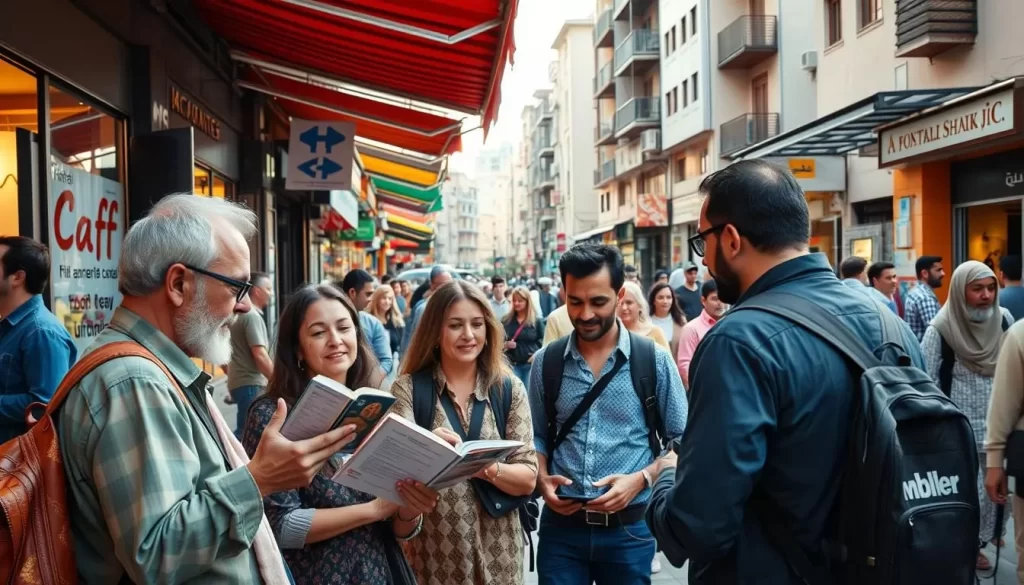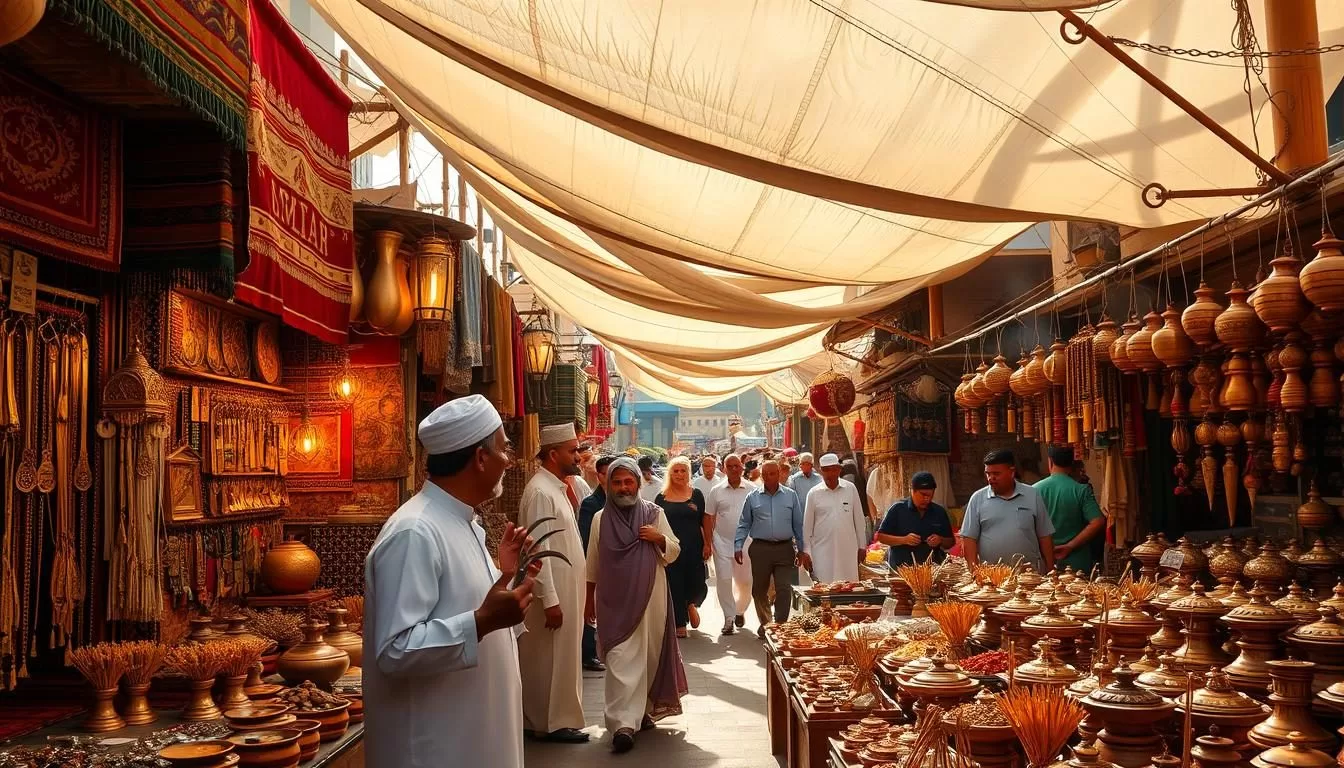✓ Accommodations✓ Flights✓ Rental Cars✓ Tours & Activities
When you explore the linguistic landscape of this country, you’ll find a fascinating mix of language and culture. Arabic stands as the official language, deeply rooted in the nation’s history and daily life. It’s the primary mode of communication, shaping everything from education to music and traditions.
Beyond Arabic, you’ll encounter Baluchi, spoken by a significant population of ethnic Baloch migrants. Immigrant tongues like English, Hindi, and Swahili also play vital roles, reflecting the country’s diverse heritage. This blend of language not only connects people but also tells the story of Oman’s rich cultural tapestry.
Introduction to Oman’s Language Landscape
Languages here tell a story of heritage and connection. In this region, the mix of tongues reflects centuries of cultural exchange. From traditional dialects to immigrant influences, every language adds a unique layer to the cultural tapestry.
Understanding the Cultural Diversity
The diversity of language in this region is a testament to its rich history. Over time, various groups have made this place their home, bringing their own dialects and traditions. This blend has created a vibrant linguistic environment.
Why Language Matters in Daily Life
Language is an essential part of daily interactions here. It connects people, preserves traditions, and fosters understanding. Whether in markets, schools, or homes, the words spoken here carry the weight of shared history and identity.
Arabic: The Official Language of Oman
Arabic stands as the cornerstone of communication in this region. Recognized as the official language, it shapes daily life, from education to business. Its roots run deep, reflecting centuries of cultural and historical significance.

Omani Arabic Dialects and Their Origins
In this region, you’ll find a variety of Arabic dialects. Shihhi and Dhofari are two prominent examples, each with unique characteristics. These dialects evolved over time, influenced by trade and cultural exchanges.
The Shihhi dialect, for instance, is commonly spoken in the northern areas. Dhofari Arabic, on the other hand, is prevalent in the southern part of the country. These distinctions highlight the linguistic diversity within the population.
Arabic in Business and Education
Arabic plays a vital role in business and education. It’s the primary language used in official documentation and academic settings. This ensures consistency and clarity in communication.
In business, Arabic fosters trust and connection. It’s the language spoken in negotiations and daily transactions, reflecting its importance in trade. Whether in government offices or classrooms, Arabic remains central to the nation’s identity.
English – A Bridge for Expatriates and Tourists
English serves as a vital link in this diverse cultural setting. It connects locals with the growing expatriate community, making daily interactions smoother. Whether you’re a tourist or an immigrant, English helps you navigate this nation with ease.
For many, English is the language spoken at work, school, and even at home. It’s not just a tool for communication but also a way to build connections. Bilingual signage and official notices make it easier for everyone to feel included.
Role in Education and Communication
In education, English is often the medium of instruction. This helps students prepare for global opportunities. Many schools focus on conversational practice, ensuring learners can use the language in real-world situations.
For expatriates, English bridges cultures and brings families closer. It’s a common ground where people from different backgrounds can connect. This makes it easier for newcomers to feel at home in a new place.
Baluchi: A Language with Deep Cultural Roots
Rooted in ancient traditions, Baluchi is a language of pride. It’s spoken by the Baloch community, a group with a rich history tied to migration and trade. This language reflects centuries of cultural exchange, making it a vital part of identity.

Baluchi is more than just words. It’s a way to preserve traditions and connect generations. Every phrase carries the weight of history, reminding the person speaking it of their heritage.
Regional Variations within Baluchi
Across different regions, Baluchi dialects vary subtly. These differences highlight local identities and historical influences. For example, the Raḵšāni dialect is widely spoken, with three distinct regional varieties.
In some areas, the language has adapted to reflect local culture. This shows how Baluchi evolves while staying true to its roots. Whether in the hills of Pakistan or the deserts of Iran, the language remains a unifying force.
Understanding these variations helps you appreciate the depth of Baluchi. It’s not just a way to communicate but a celebration of diversity and history.
Indigenous Languages of Oman and Their Preservation
Discover the hidden linguistic gems that shape this region’s identity. These rare tongues connect the past to the present, offering a glimpse into ancient traditions. Despite modernization, efforts to preserve these languages continue, ensuring their presence in the cultural fabric.
Mehri and Shehri: The South Arabian Connection
Mehri and Shehri are two indigenous languages with deep roots in South Arabian history. Spoken in remote areas, they reflect the region’s ancient heritage. Mehri, for instance, is still used by over 150,000 people, showcasing its resilience.
Shehri, on the other hand, is a testament to the cultural diversity of this part of the world. Both languages are vital to understanding the historical connections that shaped the area.
Harsusi, Bathari, and Hobyot: Endangered Tongues
Some indigenous languages face the threat of extinction. Harsusi, Bathari, and Hobyot are among the most endangered. These tongues, once widely spoken, now struggle to survive in a rapidly changing world.
Efforts to preserve these languages are ongoing. Local communities play a crucial role in keeping them alive. Their work ensures that these unique dialects remain a part of the cultural landscape.
Despite challenges, there is hope. With increased awareness and support, these endangered languages can continue to thrive. Their preservation is essential for maintaining the region’s linguistic diversity.
Immigrant Languages and Their Unique Contributions
The cultural tapestry of this region is woven with threads of diverse immigrant languages. Over the years, the influx of South Asian immigrants has enriched the linguistic scene, adding depth to the way people communicate.

Since the 1980s, languages like Urdu and Hindi have become part of daily life. These tongues reflect the vibrant heritage of South Asia and its integration into the local culture. The presence of these languages has also introduced new words and expressions, shaping the way people interact.
Influences from South Asia
South Asian immigrants have brought more than just their language. They’ve introduced cultural practices, traditions, and a unique way of life. This blend has created a dynamic linguistic environment, where words and phrases from different origins coexist.
For example, Urdu is widely spoken among the Pakistani community. Its use in markets, homes, and social gatherings highlights its importance in daily life. Similarly, Hindi has found its place in the hearts of many, connecting people across generations.
| Language | Community | Usage |
|---|---|---|
| Urdu | Pakistani | Daily conversations, markets |
| Hindi | Indian | Homes, social gatherings |
| Gujarati | Gujarati | Business, cultural events |
These languages are not just tools for communication. They are a bridge that connects people to their roots while fostering understanding in a diverse society. To learn more about the cultural richness of this region, visit this travel guide.
Regional Dialects and Historical Influences
Each corner of this country tells a story through its unique speech patterns. The dialects you hear here are more than just words—they’re a reflection of centuries of cultural exchange and migration. From the mountains to the coast, every language carries the weight of history.
Trade routes and migration have shaped the way people speak in this region. Over the years, influences from neighboring areas have blended with local traditions, creating a rich linguistic tapestry. These dialects are not just tools for communication but also a way to preserve identity.
Tracing the Roots of Arabic Variants
In this part of the world, Arabic dialects vary significantly. Each area has its own subtle differences, shaped by historical events and cultural interactions. For example, the Shihhi dialect in the north reflects influences from ancient trade routes.
In the south, the Dhofari dialect carries traces of coastal trade and maritime connections. These variations highlight the diversity within the population and show how language evolves over time. Understanding these dialects offers a deeper appreciation of the region’s heritage.
Daily conversations here are a blend of old and new. The words spoken at home often differ from those used in public, reflecting the layered history of this country. To learn more about the cultural richness of the Arabic language, visit this informative guide.
Everyday Language: Communication Tips for Travelers
Navigating daily conversations in a new place can feel overwhelming, but a few key phrases can make all the difference. Whether you’re exploring bustling markets or enjoying local hospitality, knowing the basics of the language can enhance your experience. In this country, Arabic is the primary tongue, but English is widely understood, especially in urban areas.

Useful Arabic Phrases for Visiting
Learning a few Arabic phrases can go a long way in building connections. Start with greetings like “As-salám aláykum” (peace be with you) and its reply “Waláykum as-salám”. To ask how someone is, use “Káyf hálak?” for a man and “Káyf hálik?” for a woman. These small gestures show respect and effort.
For practical situations, try these phrases:
- “Kam as-sáa?” (What time is it?)
- “Ma bíhki árabi” (I do not speak Arabic)
- “Wayn al-máta’am?” (Where is the restaurant?)
These will help you navigate daily interactions with ease.
Local Etiquette and Language Nuances
Understanding local customs is just as important as learning the language. In this country, hospitality is deeply rooted in tradition. When visiting someone’s home, it’s polite to bring a small gift and remove your shoes before entering. These gestures show appreciation for their culture.
Communication here often reflects warmth and respect. Take your time in conversations, and don’t hesitate to ask questions. Locals appreciate your effort to engage with their language and traditions. For more tips on navigating cultural interactions, check out this helpful guide.
By embracing these tips, you’ll not only communicate better but also connect more deeply with the population. Whether you’re exploring historic sites or enjoying local cuisine, these insights will make your journey unforgettable.
Oman: Official and widely spoken languages
The linguistic diversity of this nation reflects its rich cultural heritage. Arabic, the official language, is deeply rooted in daily life, shaping education, business, and traditions. It’s the primary mode of communication, connecting people across the country.
Beyond Arabic, you’ll find a vibrant mix of tongues. Baluchi, spoken by over 312,000 people, highlights the influence of ethnic Baloch migrants. Immigrant languages like Urdu, Hindi, and English also play significant roles, reflecting the multicultural makeup of the population.
This blend of language not only fosters communication but also preserves cultural identity. Women and men alike contribute to keeping these traditions alive, ensuring that the culture remains vibrant.
Demographic trends show that 45.9% of the population speaks Arabic, while immigrant languages like Malayalam and Bengali are also prevalent. This diversity is a testament to the nation’s ability to embrace both tradition and modernity.
To learn more about the linguistic landscape of this country, visit this informative guide.
Conclusion
The blend of voices in this country tells a story of unity and diversity. Over the century, the mix of language has shaped its unique identity. From the rhythms of music to the warmth of family gatherings, every word carries the weight of history and culture.
Language here is more than a tool for communication. It’s a bridge that connects generations and preserves traditions. Whether in formal settings or daily life, it plays a vital role in shaping society.
As you explore this linguistic landscape, you’ll discover the deep roots of its language. Each phrase reflects the country’s rich heritage. To learn more about the Middle East’s linguistic diversity, visit this informative guide.
The above is subject to change.
Check back often to TRAVEL.COM for the latest travel tips and deals.






